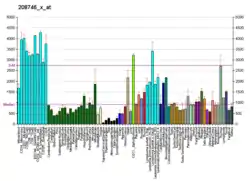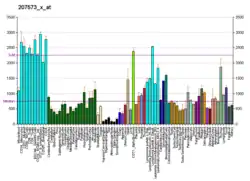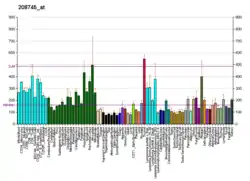ATP5L
ATP synthase subunit g, mitochondrial is an enzyme that in humans is encoded by the ATP5MG gene.[5][6][7]
| ATP-synt_G | |||||||||
|---|---|---|---|---|---|---|---|---|---|
| Identifiers | |||||||||
| Symbol | ATP-synt_G | ||||||||
| Pfam | PF04718 | ||||||||
| InterPro | IPR006808 | ||||||||
| |||||||||
Mitochondrial ATP synthase catalyzes ATP synthesis, utilizing an electrochemical gradient of protons across the inner membrane during oxidative phosphorylation. It is composed of two linked multi-subunit complexes: the soluble catalytic core, F1, and the membrane-spanning component, Fo, which comprises the proton channel. The F1 complex consists of 5 different subunits (alpha, beta, gamma, delta, and epsilon) assembled in a ratio of 3 alpha, 3 beta, and a single representative of the other 3. The Fo seems to have nine subunits (a, b, c, d, e, f, g, F6 and 8). This gene encodes the g subunit of the F0 complex.[7]
The function of subunit G is currently unknown. There is no counterpart in chloroplast or bacterial F-ATPases identified so far.[8]
References
- GRCh38: Ensembl release 89: ENSG00000167283 - Ensembl, May 2017
- GRCm38: Ensembl release 89: ENSMUSG00000038717 - Ensembl, May 2017
- "Human PubMed Reference:". National Center for Biotechnology Information, U.S. National Library of Medicine.
- "Mouse PubMed Reference:". National Center for Biotechnology Information, U.S. National Library of Medicine.
- Wiemann S, Weil B, Wellenreuther R, Gassenhuber J, Glassl S, Ansorge W, Bocher M, Blocker H, Bauersachs S, Blum H, Lauber J, Dusterhoft A, Beyer A, Kohrer K, Strack N, Mewes HW, Ottenwalder B, Obermaier B, Tampe J, Heubner D, Wambutt R, Korn B, Klein M, Poustka A (Mar 2001). "Toward a catalog of human genes and proteins: sequencing and analysis of 500 novel complete protein coding human cDNAs". Genome Res. 11 (3): 422–35. doi:10.1101/gr.GR1547R. PMC 311072. PMID 11230166.
- Zhang QH, Ye M, Wu XY, Ren SX, Zhao M, Zhao CJ, Fu G, Shen Y, Fan HY, Lu G, Zhong M, Xu XR, Han ZG, Zhang JW, Tao J, Huang QH, Zhou J, Hu GX, Gu J, Chen SJ, Chen Z (Nov 2000). "Cloning and functional analysis of cDNAs with open reading frames for 300 previously undefined genes expressed in CD34+ hematopoietic stem/progenitor cells". Genome Res. 10 (10): 1546–60. doi:10.1101/gr.140200. PMC 310934. PMID 11042152.
- "Entrez Gene: ATP5MG ATP synthase membrane subunit g".
- Collinson IR, Runswick MJ, Buchanan SK, Fearnley IM, Skehel JM, van Raaij MJ, Griffiths DE, Walker JE (June 1994). "Fo membrane domain of ATP synthase from bovine heart mitochondria: purification, subunit composition, and reconstitution with F1-ATPase". Biochemistry. 33 (25): 7971–8. doi:10.1021/bi00191a026. PMID 8011660.
External links
- Human ATP5MG genome location and ATP5MG gene details page in the UCSC Genome Browser.
Further reading
- Kinosita K, Yasuda R, Noji H (2003). "F1-ATPase: a highly efficient rotary ATP machine". Essays Biochem. 35: 3–18. doi:10.1042/bse0350003. PMID 12471886.
- Oster G, Wang H (2003). "Rotary protein motors". Trends Cell Biol. 13 (3): 114–21. doi:10.1016/S0962-8924(03)00004-7. PMID 12628343.
- Leyva JA, Bianchet MA, Amzel LM (2003). "Understanding ATP synthesis: structure and mechanism of the F1-ATPase (Review)". Mol. Membr. Biol. 20 (1): 27–33. doi:10.1080/0968768031000066532. PMID 12745923. S2CID 218895820.
- Elston T, Wang H, Oster G (1998). "Energy transduction in ATP synthase". Nature. 391 (6666): 510–3. doi:10.1038/35185. PMID 9461222. S2CID 4406161.
- Wang H, Oster G (1998). "Energy transduction in the F1 motor of ATP synthase". Nature. 396 (6708): 279–82. doi:10.1038/24409. PMID 9834036. S2CID 4424498.
- Hartley JL, Temple GF, Brasch MA (2001). "DNA cloning using in vitro site-specific recombination". Genome Res. 10 (11): 1788–95. doi:10.1101/gr.143000. PMC 310948. PMID 11076863.
- Strausberg RL, Feingold EA, Grouse LH, et al. (2003). "Generation and initial analysis of more than 15,000 full-length human and mouse cDNA sequences". Proc. Natl. Acad. Sci. U.S.A. 99 (26): 16899–903. doi:10.1073/pnas.242603899. PMC 139241. PMID 12477932.
- Cross RL (2004). "Molecular motors: turning the ATP motor". Nature. 427 (6973): 407–8. doi:10.1038/427407b. PMID 14749816. S2CID 52819856.
- Gerhard DS, Wagner L, Feingold EA, et al. (2004). "The status, quality, and expansion of the NIH full-length cDNA project: the Mammalian Gene Collection (MGC)". Genome Res. 14 (10B): 2121–7. doi:10.1101/gr.2596504. PMC 528928. PMID 15489334.
- Wiemann S, Arlt D, Huber W, et al. (2004). "From ORFeome to biology: a functional genomics pipeline". Genome Res. 14 (10B): 2136–44. doi:10.1101/gr.2576704. PMC 528930. PMID 15489336.
- Mehrle A, Rosenfelder H, Schupp I, et al. (2006). "The LIFEdb database in 2006". Nucleic Acids Res. 34 (Database issue): D415–8. doi:10.1093/nar/gkj139. PMC 1347501. PMID 16381901.
- Ewing RM, Chu P, Elisma F, et al. (2007). "Large-scale mapping of human protein-protein interactions by mass spectrometry". Mol. Syst. Biol. 3 (1): 89. doi:10.1038/msb4100134. PMC 1847948. PMID 17353931.






